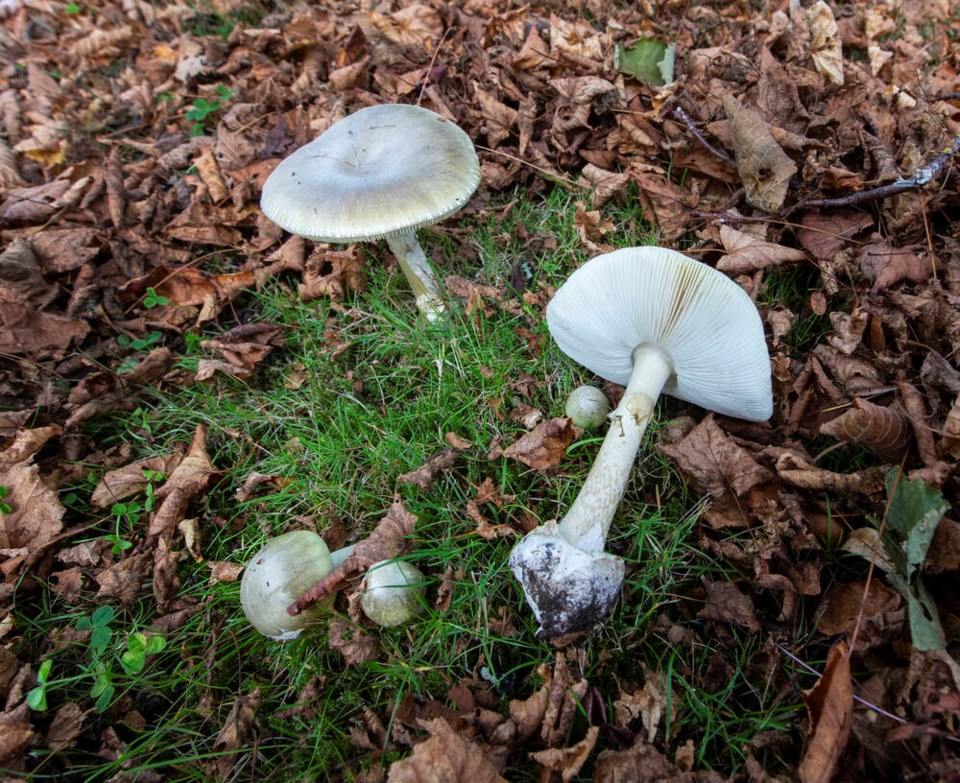The spread of the lethal death cap mushroom could get a lot worse in years to come, says a leading mycologist.
The discovery of Amanita phalloides in the roots of a native Garry oak in 2016 means the extremely toxic mushroom is adapting to new tree hosts, increasing its area and the risks of potential poisonings, says Victoria’s Shannon Berch, a retired provincial scientist and mushroom expert.
Berch made the death cap discovery near Camosun Colleges’s Interurban campus at the base of a Garry oak and near a stand of Douglas fir while on a walk. She later learned it was on the site of a long-closed nursery that had imported European trees.
The deadly mushroom found its way to Victoria attached to the roots of ornamental European hardwoods that were imported about 50 years ago and has typically been seen around English oaks, chestnuts, lindens and hornbeams.
Berch said reports that the death cap is now invading conifer forests in the Eastern U.S. and California should serve as an alarm.
“It has been kept to the cities [Victoria and Vancouver] where the imported trees have been around for some time,” Berch said. “But British Columbia’s forests are conifers. It’s astounding to think that this could happen. How long? I couldn’t speculate exactly, but it could take decades.”
Threads of the fungi travel underground via complex and intertwining root systems and its spores travel through the air. The speed of the spread is impossible to pinpoint, but when it comes to fruited mushrooms, where there’s one, others will follow.
“Today, coming across a cluster of death cap mushrooms is no longer an unusual experience on the streets of Victoria,” said mycologist Andy MacKinnon.
And the jump to native tree species is real, he said, as death caps have already made the trasition to California oaks, tanoaks and pines in the U.S. “The greatest worry has always been that will adapt to native trees and start to spread outside the cities.”
The spread of the death cap in Greater Victoria and as far north as Galiano Island and Courtenay has prompted the Island Health Authority and municipalities to issue public warnings.
“These are extremely toxic mushrooms that can cause severe illness and may be lethal if ingested by people and especially children,” said Island Health. “They can be found in various environments around Greater Victoria, and are also dangerous to pets.”
A three-year-old Victoria boy died after ingesting death caps gathered from a Victoria boulevard in 2016, the first documented case in British Columbia since the mushroom was first found in 1997 in Mission. In 2003, an Oak Bay resident barely survived after cooking and eating death caps picked on Eastdowne Road. He thought they were puffballs.
At least four dogs have also died after eating the mushrooms, with the cases spread from Fairfield to Elk/Beaver Lake.
Death caps were first documented in Greater Victoria in 1998. Since then, the Pacific Forestry Centre’s Forest Pathology Herbarium database has samples collected at Government House, from a garden on Foul Bay Road, along Richmond Avenue, under linden trees in Uplands and hornbeams beside a downtown parking lot, and near Crystal Gardens. More are being added all the time.
The mushroom is often pale and yellowish, but sometimes has shades of green. The cap flattens out and cracks as it matures. They have a distinctive, bulbous volva or cup at the base of the stem underground and a “skirt” below the cap. They usually appear in the fall, but early fruiting was seen this past summer, likely due to increased watering during the drought, Island Health said.
It often has a faint, honey-sweet smell. Death cap mushrooms are sometimes confused with edible mushrooms such as puffballs and paddy-straw mushrooms. Its toxins are stable and do not break down when cooked.
Island Health said up to 30 per cent of people who eat a death cap will die, and “liver transplants are a necessary life-saving procedure.” Early treatment in hospital is essential.
The B.C. Centre for Disease Control says nausea, vomiting and lowered blood pressure begin eight to 12 hours after ingestion. Symptoms then seem to disappear and people can feel fine for up to 72 hours, say health officials. Symptoms of liver and kidney damage start three to six days after mushrooms are eaten.
B.C.’s Drug and Poison Information Centre said calls about poisonings from mushrooms increase in the months with higher rainfalls.
If you suspect someone has eaten a poisonous mushroom, go to the hospital. You can also call the B.C. Drug and Poison Information Centre at 1-800-567-8911 or call 911. Keep a sample of the mushroom.
Berch said the death cap is here to stay, and public awareness is the only defence.
“They are impossible to get rid of.”
dkloster@timescolonist.com



